|
Retour
On
the night of May 22/23, 1944, an unknown aircraft, engulfed in flames,
shaved the bell towers of the cathedral in Sées and crashed 1 km north of
the town, at La Potence,
Communications
between the Allies and the townspeople were dangerous and difficult due to
the German occupation of the town. There were relatively few witnesses to
the crash and those who had witnessed it were unable to get messages to
the Allies.
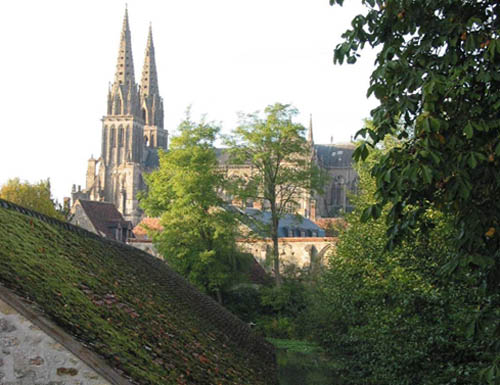
The
six airmen who were aboard the aircraft were quickly buried by the Germans
in a common grave in the civil cemetery at Sées. In England, the airbase
from which the plane departed, listed the six airmen as ‘missing in
action’, and later notices were mailed to family members advising them
that all aboard the aircraft were “presumed dead”. At the time the
notices were sent to the families, the war still raged and communications
continued to be difficult.
The
years passed and those who may have witnessed the crash have passed away
or moved away from the area or may no longer be able to remember those
horrible days of the war. Despite the passage of time, for me, the image
of the crash was something I could not drive from my memory.
After
various activities and travels around the world, in July 1998, I returned
to the area and decided to enquire about the aircraft and the crash and to
try to learn more about the mystery that had haunted me for almost 54
years. Surprisingly, I learned that no one in the town remembered the
crash, nor had the residents of the town been told about it.
It
was a particularly disturbing time for the residents, having been under
German occupation for four years. Everyone had heard about a planned
invasion by the Allied Forces and looked forward to that day. As it
happened, the crash of this aircraft occurred only two weeks prior to the
invasion of Normandy on June 6, 1944. The residents of the town then had
hope for freedom and the memories of the mysterious crash were pushed to
the back of their minds. In fact, almost another 12 months would pass
before VE Day and many more months after that before lives returned to
normal.
After
visiting the town and asking questions, I decided that I would continue my
investigation, but how? I could not remember the precise date of the drama
but I found a burial register for the civil cemetery where it was recorded
that six unknown airmen had been buried there in a common grave on May 22,
1944. Further information was obtained from the Commonwealth War Graves
Commission where a report told of the six bodies beening exhumed from the
cemetery at Sées and re-interred at the Canadian War Cemetery at
Bretteville-sur-Laize in late 1945.
The
date of May 22, 1944 which I discovered on the burial register would
enable me to contact the British Air Ministry and the Royal Air Force. The
Ministry of Defense quickly responded to my letter in August 1998 and I
learned there was a crew reported missing on the night of 22/23 May 1944.
The
Ministry of Defense reported that a Whitley bomber (24 OTU) departed Long Marston
on the night of May 22. The mission was to drop leaflets (Nickel Sortie)
over Alençon, and to also take strategic photographs of the area around
Alençon, Le Mans and Laval, and to return to base in the early hours of
May 23.
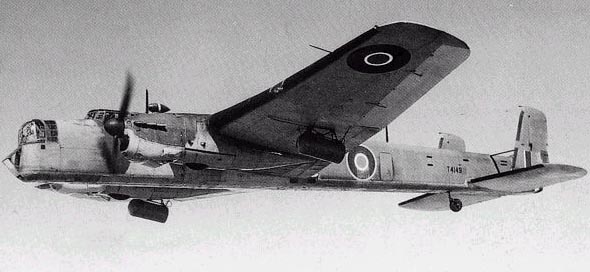
There
was confusion, however, when I discovered the written report submitted by
the local French gendarme, in which the date of May 23, 1944 was reported
as the date of the crash. From this report I learned there had been
several items belonging to the crew found at the crash site – maps of
occupied Europe that were printed on silk, identity photographs, a
dictionary, and French francs. This information immediately made me think
of an Allied aircraft.
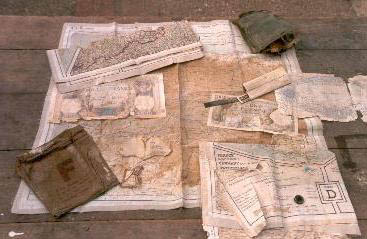
The Air Ministry provided the names of the six
airmen and without hesitation I asked the local newspaper, ‘L’Orne
Hebdo,’ to publish the names which appeared in the November 25, 2003
edition of the newspaper. It was also learned that the aircraft had been
shot down by the DCA battery that was located at the bridge at Madeleine
meadows.
With
great surprise, almost 60 years after the crash, I learned there was a
witness to the crash. Gerard Malherbe contacted the newspaper to report he
was in possession of an identity photograph of one of the airmen that was
found at the crash site in 1944. Another witness, Gerald
Buvron,
came forward with a ring that was also found at the crash site. The gold
signet ring is engraved with “Grand Valley, C.A.S.”, on the top and
the initials, “WGH” on the inside of the ring.
The
ring has been kept by the Buvron family and it has been polished and
caringly preserved for 60 years. Mr. Buvron checked the initials in the
ring and they matched the initials of Sergeant Wilfred Gordon Harris, an
air gunner with the Royal Canadian Air Force.
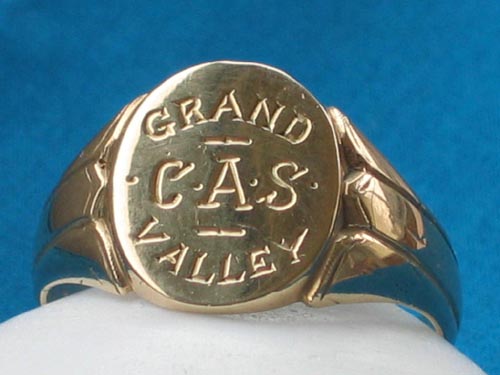
Coincidental
postings, on the same day, to a website in England, by me and by Mrs.
Shirley Stone, from Ontario, Canada, resulted in Mrs. Stone offering to
assist me in trying to locate the family of Sergeant Harris.
In
less than a week contact had been made with the brother of Sgt. Harris.
Jim Harris was 12 years of age when his brother was killed and it came as
a great shock to Mr. Harris to learn his brother rested in a proper grave.
Mr. Harris said the town of Grand Valley presented signet rings to all
servicemen who were posted overseas. This ring certainly confirmed the
identity of the crew who lost their lives in the crash of May 22, 1944.
Upon
learning there were five other crewmen who perished in the crash, Mrs.
Stone offered to search for the other families. With determination, Mrs.
Stone began writing letters, sending e.mails, and making telephone calls
to arrange for articles in various publications in Canada. Contact was
made with the Royal Canadian Air Force, The Royal Canadian Legion, the Air
Force Association, the RCAF museums in Trenton, Ontario and in Brandon,
Manitoba, and the National Archives of Canada. Articles were published in
the Globe and Mail, the Vittoria Booster, and the Quebec Tribune as well
as reports on the local television channel in Drummonville, Quebec, and a
report by Tom Kennedy of CTV, a Canadian national television station.
Mrs.
Stone located the friend of Flight Officer, Pilot, David Webster Goodwin
and it was confirmed that the photo found by Gerard Malherbe was a photo
of David Webster. Soon contact had been made with the families of F/O
Navigator Joseph Hong, F/O Air Bomber Charles Beverly Wyckoff,
Warrant
Officer Air Bomber Joseph Gaston Jacques, and the wife of David Webster
Goodwin.
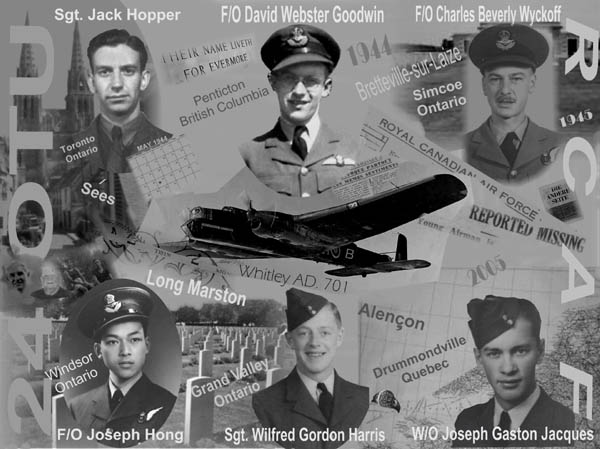
Collage
réalisé par mme Shirley Stone
When
each family was contacted, Mrs. Stone relayed the information to me and I
was able to
write
letters to the families which provided information about the crash and the
location of the graves.
Unbelievably,
we learned that only two of the six families had been notified of the
location of the graves at Bretteville-sur-Laize. The other families had
always thought the aircraft had crashed in the sea or the English Channel.
So
many years of research, anguish and unanswered questions for these
families and it is with sadness and with joy that we share their emotions
upon learning about the fate of their loved ones. Unanamously the families
tell us – “Our lives have changed since learning the truth about this
crash. We finally have learned about our loved ones - their lives overseas,
their courage, their duties to their nation, and the attachments to their
families. We cannot express in words our feelings after learning about the
location of the graves”.
Roger
cornevin-hayton living in sees ( orne ), till 1944
To see the article on the Canadian TV:
Clic
here
(the clip video is to see on the right of the page)
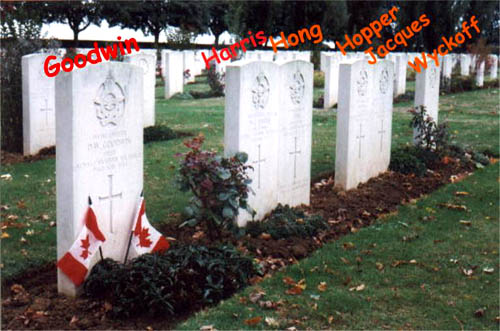
Retour
en haut de la page
|
Thank you to ask for the author's authorization for a partial or complete publication of this narration
|
|